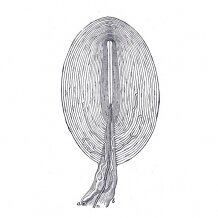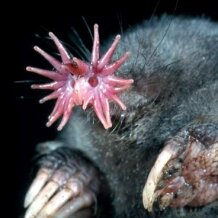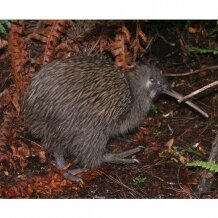Topic: Pressure sensitivity and the tactile sense (excluding the lateral line)
Categories: Anatomy, Arthropods: other than Insects, Birds, Brains & Intelligence, Feeding, Mammals, Physiology, Senses
The star-nosed mole is famous for, well, its nose, but do you have any idea what these peculiar 'tentacles' are for? The answer is rather touching and, of course, convergent...
Energy propagated through the air results in sound, and not surprisingly hearing is rampantly convergent (as is the related case of echolocation).  If, however, the propagation is through the ground or if the animal presses tactile organs against the substrate, then we enter a rather different set of sensory modalities. Needless to say they are convergent as well, but in certain cases (most famously in the star-nosed mole Condylura cristata) the system shows striking parallels with other sensory systems. In addition, there is a direct link to seismic communication and the lateral line system. The mechanosensory operation revolves around a rather complex anatomy, but central are very small Pacinian (or paciniform) corpuscles and so-called Merkel cell-neurite complexes. Both are types of touch receptor in the skin that detect changes in pressure and vibrations. Pacinian corpuscles are constructed like a minute onion, consisting of a nerve ending wrapped in lamellated layers of connective tissue that enclose a fluid-filled cavity. Merkel cell-neurite complexes comprise a receptor cell, the so-called Merkel cell, and an enlarged nerve ending.
If, however, the propagation is through the ground or if the animal presses tactile organs against the substrate, then we enter a rather different set of sensory modalities. Needless to say they are convergent as well, but in certain cases (most famously in the star-nosed mole Condylura cristata) the system shows striking parallels with other sensory systems. In addition, there is a direct link to seismic communication and the lateral line system. The mechanosensory operation revolves around a rather complex anatomy, but central are very small Pacinian (or paciniform) corpuscles and so-called Merkel cell-neurite complexes. Both are types of touch receptor in the skin that detect changes in pressure and vibrations. Pacinian corpuscles are constructed like a minute onion, consisting of a nerve ending wrapped in lamellated layers of connective tissue that enclose a fluid-filled cavity. Merkel cell-neurite complexes comprise a receptor cell, the so-called Merkel cell, and an enlarged nerve ending.
Moles
Perhaps the classic example is the remarkable mechanosensory system of the moles, especially the star-nosed mole. Whilst most mammals employ vibrissae (whiskers), the nose of moles is studded with button-like structures known as Eimer's organs. These touch receptors are specialisations of the epidermis that consist of bulbous papillae containing free nerve endings, Merkel cell-neurite complexes and paciniform corpuscles in the dermal connective tissue. They serve to transduce surface features and textures - not by rubbing but by direct application - and allow the mole to make rapid tactile discriminations when foraging and investigating its surroundings. The resolution of these tactile signals seems to be impressive, and moles might also have a tuning capacity for filtering out irrelevant data.
 The aptly named star-nosed mole possesses one of the most sophisticated touch specialisations of all mammals. The edges of its elaborate nose are extended into flexible 'tentacles' that are composed of about 25,000 Eimer's organs. The receptive fields of individual somatosensory neurons are amongst the smallest known in mammals (effectively equivalent to a large number of pixels). This contributes to the mole's exceptional tactile acuity - it is adept at rapidly finding and assessing small pieces of food and can map out a substantial area of its tunnels with its ceaseless tentacle movement. In terms of handling speed, it appears that this animal has effectively reached the limit of how much tactile information can be processed - it simply cannot get any better. Even more intriguing is the striking convergence of the mole's nose with the vertebrate visual system that even extends to the organisation of the neocortex. Analogous to the fovea of the eye, the star-nosed mole possesses a tactile fovea on one pair of tentacles, where the density of touch receptors is particularly high. It performs frequent nasal saccades to bring objects of interest into contact with this fovea, and these movements strongly resemble those seen in the saccadal movement of our eyes.
The aptly named star-nosed mole possesses one of the most sophisticated touch specialisations of all mammals. The edges of its elaborate nose are extended into flexible 'tentacles' that are composed of about 25,000 Eimer's organs. The receptive fields of individual somatosensory neurons are amongst the smallest known in mammals (effectively equivalent to a large number of pixels). This contributes to the mole's exceptional tactile acuity - it is adept at rapidly finding and assessing small pieces of food and can map out a substantial area of its tunnels with its ceaseless tentacle movement. In terms of handling speed, it appears that this animal has effectively reached the limit of how much tactile information can be processed - it simply cannot get any better. Even more intriguing is the striking convergence of the mole's nose with the vertebrate visual system that even extends to the organisation of the neocortex. Analogous to the fovea of the eye, the star-nosed mole possesses a tactile fovea on one pair of tentacles, where the density of touch receptors is particularly high. It performs frequent nasal saccades to bring objects of interest into contact with this fovea, and these movements strongly resemble those seen in the saccadal movement of our eyes.
Monotremes
 A remarkably similar sensory structure has arisen independently in the monotremes (which have also independently evolved electroreception). These mammals use hair-like touch receptors called push rods, which are basically the same as Eimer's organs. Push rods are best developed in the duck-billed platypus (Ornithorhynchus anatinus), where almost 50,000 are distributed all over the bill skin (and have a correspondingly large area dedicated to them in the brain). Each rod is isolated from the surrounding epidermis, allowing them to move independently of each other. They consist of rigid columns of flattened cells that, like in Eimer's organs, are associated with nerve endings, Merkel cell-neurite complexes and lamellated corpuscles. Their receptive fields are similar as well, and there is little doubt the duck-billed platypus lives in a very tactile world. Push rods have also been found in the short-beaked echidna (Tachyglossus aculeatus) and the Western long-beaked echidna (Zaglossus bruijnii), but they seem to be less differentiated and less specialised for mechanoreception.
A remarkably similar sensory structure has arisen independently in the monotremes (which have also independently evolved electroreception). These mammals use hair-like touch receptors called push rods, which are basically the same as Eimer's organs. Push rods are best developed in the duck-billed platypus (Ornithorhynchus anatinus), where almost 50,000 are distributed all over the bill skin (and have a correspondingly large area dedicated to them in the brain). Each rod is isolated from the surrounding epidermis, allowing them to move independently of each other. They consist of rigid columns of flattened cells that, like in Eimer's organs, are associated with nerve endings, Merkel cell-neurite complexes and lamellated corpuscles. Their receptive fields are similar as well, and there is little doubt the duck-billed platypus lives in a very tactile world. Push rods have also been found in the short-beaked echidna (Tachyglossus aculeatus) and the Western long-beaked echidna (Zaglossus bruijnii), but they seem to be less differentiated and less specialised for mechanoreception.
Fossorial mammals
 Not surprisingly, underground mammals other than the moles also show a tactile-based sensory system, and here too we find interesting convergences. As noted above, the great majority of mammals employ vibrissae. In naked mole rats (Heterocephalus glaber), however, the sparse body hairs are arranged in a grid-like manner and evidently serve the same role as the vibrissae. Even more remarkable is the evidence that an enormous area in the brain is dedicated to the upper and lower incisors (the latter of which can be moved independently). These teeth therefore seem to be central to the world of the naked mole rat and are employed in multiple tasks, including digging, feeding and social interactions. In passing we should note that the aquatic manatees have a series of postcranial tactile hairs that are probably pressure sensitive as well.
Not surprisingly, underground mammals other than the moles also show a tactile-based sensory system, and here too we find interesting convergences. As noted above, the great majority of mammals employ vibrissae. In naked mole rats (Heterocephalus glaber), however, the sparse body hairs are arranged in a grid-like manner and evidently serve the same role as the vibrissae. Even more remarkable is the evidence that an enormous area in the brain is dedicated to the upper and lower incisors (the latter of which can be moved independently). These teeth therefore seem to be central to the world of the naked mole rat and are employed in multiple tasks, including digging, feeding and social interactions. In passing we should note that the aquatic manatees have a series of postcranial tactile hairs that are probably pressure sensitive as well.
Birds
 The Scolopacidae, a family of shorebirds that includes the sandpipers, possess elongated bills, which they use to probe coastal mudflats and sands for buried invertebrates. Intriguingly, most species do not need to touch their prey directly but use a sensory structure in the bill tip that provides a remote touch sense. This bill-tip organ consists of a set of characteristic bony pits housing clusters of mechanosensory cells known as Herbst corpuscles. These corpuscles are strongly convergent with the Pacinian corpuscles of mammals and evidently serve to detect pressure gradients within the sediment. The precise mechanism of prey localisation, however, is still unknown.
The Scolopacidae, a family of shorebirds that includes the sandpipers, possess elongated bills, which they use to probe coastal mudflats and sands for buried invertebrates. Intriguingly, most species do not need to touch their prey directly but use a sensory structure in the bill tip that provides a remote touch sense. This bill-tip organ consists of a set of characteristic bony pits housing clusters of mechanosensory cells known as Herbst corpuscles. These corpuscles are strongly convergent with the Pacinian corpuscles of mammals and evidently serve to detect pressure gradients within the sediment. The precise mechanism of prey localisation, however, is still unknown.
 The flightless kiwis (genus Apteryx) of New Zealand, which are famous for their convergences with nocturnal mammals, forage by probing the soil with their long, slightly down-curved bill in search of small invertebrates. It was long believed that they mainly rely on their acute sense of smell, but a recent study has found that kiwis possess a bill-tip organ analogous to that of the Scolopacidae. They furthermore share some foraging patterns and might thus employ a similar remote-tactile prey detection mechanism. In both groups, the principal sensory trigeminal nucleus, the brain region that relays tactile information to the telencephalon, is enlarged. The fact that kiwis and scolopacids belong to two very different lineages of birds - the former to the (ostensibly more primitive) Palaeognathae and the latter to the Neognathae - "suggests convergent evolution of a complex sensory system across a deep taxonomic divide" (Cunningham et al. 2007, Journal of Anatomy, vol. 211, p. 498).
The flightless kiwis (genus Apteryx) of New Zealand, which are famous for their convergences with nocturnal mammals, forage by probing the soil with their long, slightly down-curved bill in search of small invertebrates. It was long believed that they mainly rely on their acute sense of smell, but a recent study has found that kiwis possess a bill-tip organ analogous to that of the Scolopacidae. They furthermore share some foraging patterns and might thus employ a similar remote-tactile prey detection mechanism. In both groups, the principal sensory trigeminal nucleus, the brain region that relays tactile information to the telencephalon, is enlarged. The fact that kiwis and scolopacids belong to two very different lineages of birds - the former to the (ostensibly more primitive) Palaeognathae and the latter to the Neognathae - "suggests convergent evolution of a complex sensory system across a deep taxonomic divide" (Cunningham et al. 2007, Journal of Anatomy, vol. 211, p. 498).
Remote touch sensory systems may have evolved even more often in probing birds, as bill-tip organs have recently been described in a third family, the cosmopolitan ibises (Threskiornithidae). However, the phylogenetic relationship between ibises and scolopacids is still controversial, and whilst less likely the inheritance of a bill-tip organ from a common ancestor cannot be ruled out at present.
Invertebrates
In a way reminiscent of the naked mole rats and manatees, the marine arrow worms (Chaetognatha), which are known for their use of tetrodotoxin to subdue prey, have an array of hairs in a species-specific fan pattern. These evidently act as mechanoreceptors in this very successful predatory group, sensing prey-generated vibrations.
An interesting parallel is found in cave-dwelling crustaceans in the genera Potamalpheops, Macrobrachium and Procambarus. Here, the eyes are rendered redundant, but fine setae on the surface of the cornea may perform a tactile function (although a role in chemosensation is another possibility). This redeployment of the corneal setae appears to have happened independently in the three genera, as the setae differ in their structure. It has been argued that the convergence might be due to the strong selective pressures experienced in similar cave environments, where food is generally scarce and structures that aid in finding food provide a selective advantage.
Cite this web page
Map of Life - "Pressure sensitivity and the tactile sense (excluding the lateral line)"
https://mapoflife.org/topics/topic_454_Pressure-sensitivity-and-the-tactile-sense-(excluding-the-lateral-line)/
September 16, 2015
(Topic created 22nd June 2009) | Last modified: 22nd July 2010
Please note: words or phrases shown in bold in the PRINT VERSION of this text normally indicate hyperlinks on the webpage. These generally return a list of search results based on that keyword.